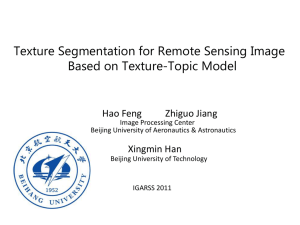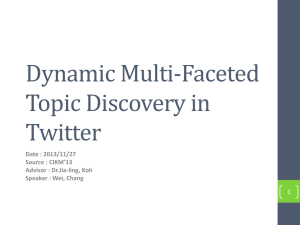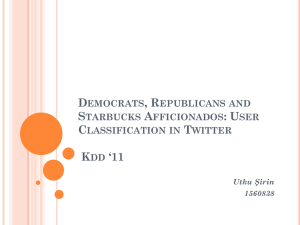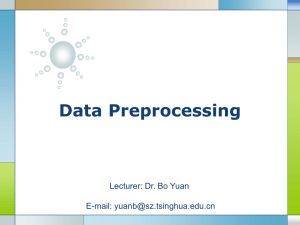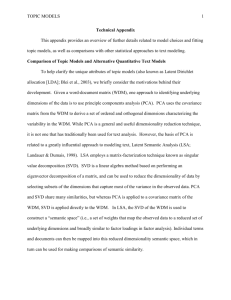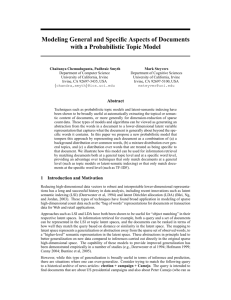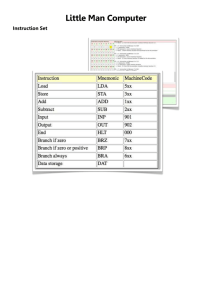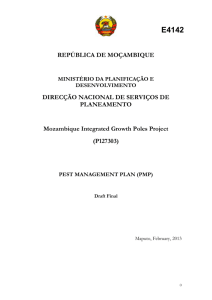Slides - Information Sciences Institute
advertisement
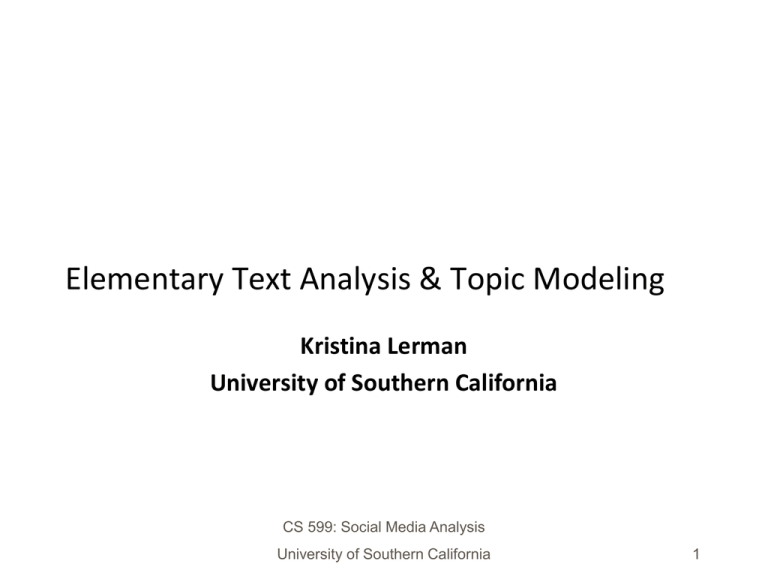
Elementary Text Analysis & Topic Modeling Kristina Lerman University of Southern California CS 599: Social Media Analysis University of Southern California 1 Why topic modeling • Volume of collections of text document is growing exponentially, necessitating methods for automatically organizing, understanding, searching and summarizing them • Uncover hidden topical patterns in collections. • Annotate documents according to topics. • Using annotations to organize, summarize and search. Topic Modeling NIH Grants Topic Map 2011 NIH Map Viewer (https://app.nihmaps.org) Brief history of text analysis • 1960s – Electronic documents come online – Vector space models (Salton) – ‘bag of words’, tf-idf • 1990s – Mathematical analysis tools become widely available – Latent semantic indexing (LSI) – Singular value decomposition (SVD, PCA) • 2000s – Probabilistic topic modeling (LDA) – Probabilistic matrix factorization (PMF) Readings • Blei, D. M. (2012). Probabilistic topic models. Communications of the ACM, 55(4):77-84. – Latent Dirichlet Allocation (LDA) • Yehuda Koren, Robert Bell and Chris Volinsky. Matrix Factorization Techniques For Recommender Systems. In Journal of Computer, 2009. Vector space model Term frequency • genes 5 • organism 3 • survive 1 • life 1 • computer 1 • organisms 1 • genomes 2 • predictions 1 • genetic 1 • numbers 1 • sequenced 1 • genome 2 • computational 1 • … Vector space models: reducing noise • • • • • • • • • • • • • genes 5 organism 3 survive 1 life 1 computer 1 organisms 1 genomes 2 predictions 1 genetic 1 numbers 1 sequenced 1 genome 2 computational 1 remove stopwords stem words original • • • • • • • • • gene 6 organism 4 survive 1 life 1 comput 2 predictions 1 numbers 1 sequenced 1 genome 4 • • • • • • • • • • • • • and or but also to too as can I you he she … Vector space model • Each document is a point in high-dimensional space Document 2 gene 0 organism 6 survive 1 life 1 comput 2 predictions 1 numbers 1 sequenced 1 genome 4 … organism gene … Document 1 gene 6 organism 4 survive 1 life 1 comput 2 predictions 1 numbers 1 sequenced 1 genome 4 … Vector space model • Each document is a point in high-dimensional space Document 2 gene 0 organism 6 survive 1 life 1 comput 2 predictions 1 numbers 1 sequenced 1 genome 4 … organism q gene … • Compare two documents: similarity ~ cos(q) Document 1 gene 6 organism 4 survive 1 life 1 comput 2 predictions 1 numbers 1 sequenced 1 genome 4 … Improving the vector space model • Use tf-idf, instead of term frequency (tf), in the document vector – Term frequency * inverse document frequency – E.g., • ‘computer’ occurs 3 times in a document, but it is present in 80% of documents tf-idf score ‘computer’ is 3*1/.8=3.75 • ‘gene’ occurs 2 times in a document, but it is present in 20% of documents tf-idf score of ‘gene’ is 2*1/.2=10 Some problems with vector space model • Synonymy – Unique term corresponds to a dimension in term space – Synonyms (‘kid’ and ‘child’) are different dimensions • Polysemy – Different meanings of the same term improperly confused – E.g., document about river ‘banks’ will be improperly judged to be similar to a document about financial ‘banks’ Latent Semantic Indexing • Identifies subspace of tf-idf that captures most of the variance in a corpus – Need a smaller subspace to represent document corpus – This subspace captures topics that exist in a corpus • Topic = set of related words • Handles polysemy and synonymy – Synonyms will belong to the same topic since they may co-occur with the same related words LSI, the Method • Document-term matrix A • Decompose A by Singular Value Decomposition (SVD) – Linear algebra • Approximate A using truncated SVD – Captures the most important relationships in A – Ignores other relationships – Rebuild the matrix A using just the important relationships LSI, the Method (cont.) Each row and column of A gets mapped into the k-dimensional LSI space, by the SVD. Singular value decomposition • SVD- Singular value decomposition http://en.wikipedia.org/wiki/Singular_value_decomposition Lower rank decomposition • Usually, rank of the matrix A is small: r<<min(m,n). – Only a few of the largest eigenvectors (those associated with the largest eigenvalues l) matter – These r eigenvectors define a lower dimensional subspace that captures most important characteristics of the document corpus – All operations (document comparison, similar) can be done in this reduced-dimension subspace Probabilistic Modeling • Generative probabilistic modeling • Treats data as observations • Contains hidden variables • Hidden variables reflect the themes that pervade a corpus of documents • Infer hidden thematic structure • Analyze words in the documents • Discover topics in the corpus • A topic is a distribution over words – Large reduction in description length • Few topics are needed to represent themes in a document corpus – about 100 LDA – Latent Dirichlet Allocation (Blei 2003) Intuition: Documents have multiple topics Topics • A topic is a distribution over words • A document is a distribution over topics • A word in a document is drawn from one of those topics Document Topics Generative Model of LDA • Each topic is a distribution over words • Each document is a mixture of corpus-wide topics • Each word is drawn from one of those topics LDA inference • We observe only documents • The rest of the structure are hidden variables LDA inference • Our goal is to infer hidden variables • Compute their distribution conditioned on the documents p(topic, proportions, assignments | documents) Posterior Distribution • Only documents are observable. • Infer underlying topic structure. • Topics that generated the documents. • For each document, distribution of topics. • For each word, which topic generated the word. • Algorithmic challenge: Finding the conditional distribution of all the latent variables, given the observation. LDA as Graphical Model • Encodes assumptions • Defines a factorization of the joint distribution LDA as Graphical Model • Nodes are random variables; edges indicate dependence • Shaded nodes are observed; unshaded nodes are hidden • Plates indicate replicated variables Posterior Distribution • This joint defines a posterior p(q, z, b|W): • From a collection of documents W, infer • Per-word topic assignment zd,n • Per-document topic proportions qd • Per-corpus topic distribution k Posterior Distribution • Evaluate p(z|W): posterior distribution over the assignment of words to topic. • q and can be estimated. • Computing p(z|W) involves evaluating a probability distribution over a large discrete space. Approximate posterior inference algorithms • • • • • • Mean field variational methods Expectation propagation Gibbs sampling Distributed sampling … Efficient packages for solving this problem Example • Data: collection of Science articles from 1990-2000 – 17K documents – 11M words – 20K unique words (stop words and rare words removed) • Model: 100-topic LDA Extensions to LDA • Extension to LDA relax assumptions made by the model – “bag of words” assumption: order of words does not matter • in reality, the order of words in the document is not arbitrary – Order of documents does not matter • But in historical document collection, new topics arise – Number of topics is known and fixed • Hierarchical Baysian models infer the number of topics How useful are learned topic models • Model evaluation – How well do learned topics describe unseen (test) documents – How well it can be used for personalization • Model checking – Given a new corpus of documents, what model should be used? How many topics? • Visualization and user interfaces • Topic models for exploratory data analysis Recommender systems • Personalization tools allow filtering large collections of movies, music, tv shows, … to recommend only relevant items to people – Build a taste profile for a user – Build topic profile for an item – Recommend items that fit user’s taste profile • Probabilistic modeling techniques – Model people instead of documents to learn their profiles from observed actions • Commercially successful (Netflix competition) The intuition User-item rating prediction Items … Ratings Users 4.0 5.0 1.0 2.0 … Collaborative filtering • Collaborative filtering analyzes users’ past behavior and relationships between users and items to identify new useritem associations – Recommend new items that “similar” users liked – But, “cold start” problem makes it hard to make recommendations to new users • Approaches – Neighborhood methods – Latent factor models Neighborhood methods • Identify similar users who like the same movies. • User their ratings of other movies to recommend new movies to user Latent factor models • Characterize users and items by 20 to 100 factors, inferred from the ratings patterns Probabilistic Matrix Factorization (PMF) Item Item: distribution over topics D Topic K V Item D User N TV series, Classic, Action… R Drama, Family, … User N Topic K U R=UTV Marvel’s hero, Classic, Action... User: distribution over topics Singular Value Decomposition Probabilistic formulation “PMF is a probabilistic linear model with Gaussian observation noise that handles very large and possibly sparse data.” Item D Topic K V Item’s topics lv D V Item UTV User R D N R User’s topics lu U N User N Topic K U PMF [Salakhutdinov & Mnih 08] Inference Minimize regularized error by • Stochastic gradient descent (http://sigter.org/~simon/journal/20051211.html) – Compute prediction error for a set of parameters – Find the gradient (slope) of parameters – Modify parameters by a magnitude proportional to negative of the gradient • Alternating least squares – When one parameter is unknown, becomes an easy quadratic function that can be solved using least squares – Fix U, find V using least squares. Fix V, find U using least squares Application: Netflix challenge 2006 contest to improve movie recommendations • Data – 500K Netflix users (anonymized) – 17K movies – 100M ratings on scale of 1-5 stars • Evaluation – Test set of 3M ratings (ground truth labels withheld) – Root-mean-square error (RMSE) on the test set • Prize – $1M for beating Netflix algorithm by 10% on RMSE – If no winner, $50K prize to leading team Factorization models in the Netflix competition • Factorization models gave leading teams an advantage – Discover most descriptive “dimensions” for predicting movie preferences … Performance of factorization models • Model performance depends on complexity Netflix algorithm: RMSE=0.9514 Grand prize target: RMSE=0.8563 Summary • Hidden factors create relationships among observed data – Document topics give rise to correlations among words – User’s tastes give rise to correlations among her movie ratings • Methods for inferring hidden (latent) factors from observations – Latent semantic indexing (SVD) – Topic models (LDA, etc.) – Matrix factorization (SVD, PMF, etc.) • Trade off between model complexity, performance and computational efficience Tools • Topic modeling 1. Blei's LDA w/ "variational method" (http://cran.rproject.org/web/packages/lda/) or 2. "Gibbs sampling method" (https://code.google.com/p/plda/ and http://gibbslda.sourceforge.net/) • PMF 1. Matlab implementation (http://www.cs.toronto.edu/~rsalakhu/BPMF.html) 2. Blei's CTR code (http://www.cs.cmu.edu/~chongw/citeulike/).


